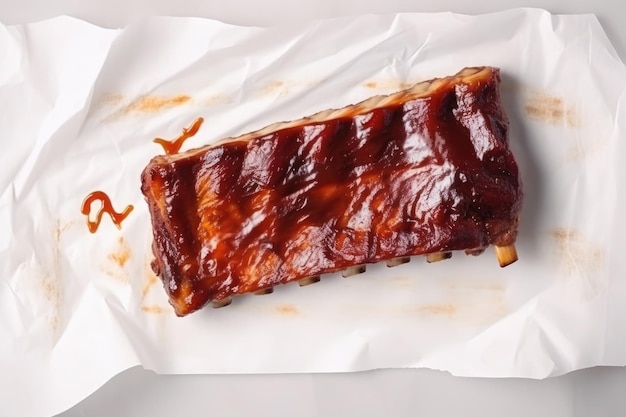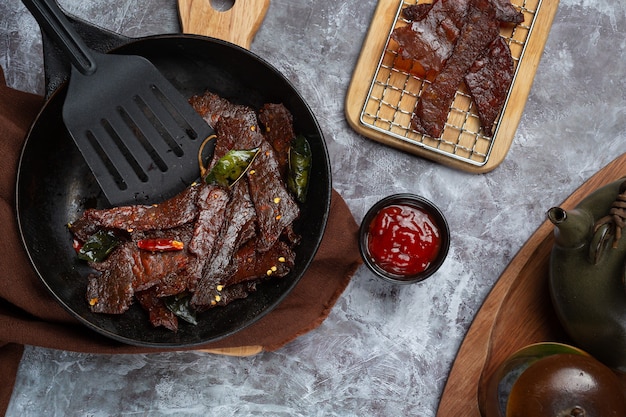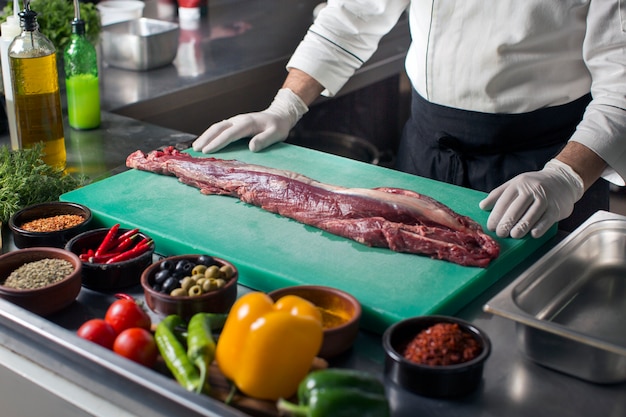I’ve always been a big fan of barbecue, and ribs hold a special place in my heart. There’s just something about that smoky flavor and melt-in-your-mouth texture that gets me every time. But let’s face it, cooking ribs can be a bit of a gamble. You might end up with tough, dry ribs or, worse, those pale, flavorless ones.
So, how do you ensure those ribs turn out perfectly tender and flavorful every time? The secret? Cooking them low and slow at 250 degrees Fahrenheit. This technique is all about patience and letting time work its magic, allowing the meat to become incredibly tender and absorb all the smoky goodness.
But how long do you cook them at this temperature? Well, that’s where things can get a bit confusing. There are so many different opinions and suggestions floating around, and it can be difficult to know where to start.
This guide is here to cut through the noise and give you a clear and simple answer. We’ll delve into the science behind low and slow cooking, break down the perfect cook times for different types of ribs, and uncover the secrets to achieving that coveted "fall-off-the-bone" texture.
(Part 1) The Holy Trinity of Rib Perfection: Tenderness, Flavor, and smoke ring

Before we dive into the specifics of cooking times, let's establish what truly makes a perfect rib. It's not just about juicy meat; it's about the perfect harmony of three essential elements: tenderness, flavor, and that elusive smoke ring.
Tenderness: Melt-in-Your-Mouth Magic
Tenderness is the foundation of any good rib. We're talking about ribs that practically melt in your mouth, so tender they practically fall off the bone. This is achieved through the slow cooking process at 250 degrees, where time allows the connective tissues in the ribs to break down, transforming tough meat into a symphony of delicate flavors.
Flavor: Rubs, Sauces, and Smokes
Flavor is what brings those ribs to life. A good rub is essential for that initial layer of flavor, infusing the meat with a rich blend of spices and herbs. Then, comes the sauce – the final touch of sweet, tangy, or spicy goodness that elevates the ribs to new heights. And let's not forget the smoke! It adds a subtle, almost mystical depth of flavor that only low and slow cooking can achieve.
The Smoke Ring: A Visual and Flavorful Delight
While not essential, a smoke ring adds a beautiful visual appeal and a subtle smoky flavor to the ribs. It's created during the smoking process when the smoke reacts with the meat's myoglobin, forming a reddish-pink layer under the surface. A smoke ring is like a badge of honor, a testament to the meticulous care taken in slow-cooking the ribs.
(Part 2) The Science of Slow Cooking: Why 250 Degrees is the Magic Number

Why 250 degrees? Why not higher? Because it’s the sweet spot for achieving that perfect balance of tenderness and flavor.
Low and Slow: Breaking Down the Tough Stuff
Cooking ribs at 250 degrees allows for a slow and even cooking process, ensuring the meat cooks gently and consistently. This low temperature is crucial for breaking down the connective tissues in the ribs, resulting in that melt-in-your-mouth tenderness.
Smoke Penetration: The Essence of Flavor
At 250 degrees, the smoke can penetrate the meat more effectively, creating that beautiful smoke ring and adding a depth of smoky flavor that's impossible to achieve at higher temperatures. Imagine it like this: The smoke acts like a gentle caress, permeating the meat, leaving behind its delicious signature.
(Part 3) The Cook Time Guide: From Baby Backs to spare ribs

Now, let's get down to brass tacks – the actual cooking times. Remember, these are guidelines, and the exact time will vary depending on the size and thickness of the ribs, the type of smoker or oven you use, and even the weather conditions.
Baby back ribs: The Classic Choice
3-4 hours: For a 2-3 rack of baby back ribs, you can expect to cook them for approximately 3-4 hours.
4-5 hours: If you’re cooking a larger quantity (4-5 racks), you’ll need to add an extra hour or so to the cooking time.
Spare Ribs: Meaty and Flavorful
5-6 hours: Spare ribs tend to be larger and meatier than baby back ribs, so they require a longer cooking time. Expect to cook a 2-3 rack for around 5-6 hours.
6-7 hours: For a larger quantity (4-5 racks), add another hour to the cooking time.
St. Louis Ribs: A Happy Medium
4-5 hours: St. Louis ribs, known for their thick, meaty slabs, typically take around 4-5 hours to cook for a 2-3 rack.
5-6 hours: For a larger quantity (4-5 racks), you’ll need to cook them for about 5-6 hours.
(Part 4) The meat thermometer: Your Trusted Companion
While the above guide gives you a good starting point, the most reliable way to know if your ribs are done is to use a meat thermometer.
The "Tenderness" Test
Insert the probe thermometer into the thickest part of the rib, aiming for the area between the bone and the meat. You want the internal temperature to reach at least 190-195 degrees Fahrenheit. This temperature indicates that the collagen in the ribs has broken down, ensuring that melt-in-your-mouth tenderness we're aiming for.
(Part 5) The 3-2-1 Method: A Step-by-Step Guide to Rib Perfection
The 3-2-1 method is a tried-and-true approach to achieving perfect ribs, breaking down the cooking process into three distinct stages.
Stage 1: 3 Hours of Smoking (The Flavor Builder)
In this first stage, you smoke the ribs uncovered for 3 hours at 250 degrees. This step focuses on developing that beautiful smoke ring and infusing the ribs with a rich smoky flavor.
Stage 2: 2 Hours of Wrapping (The Tenderizer)
After 3 hours, wrap the ribs tightly in aluminum foil, adding a little butter, apple juice, or your favorite barbecue sauce. This helps to steam the ribs, further tenderizing the meat and creating a succulent, juicy texture.
Stage 3: 1 Hour of Glazing (The Finishing Touch)
In the final hour, remove the foil and baste the ribs with your favorite barbecue sauce. This creates a sticky, delicious glaze that caramelizes and adds another layer of flavor to your ribs.
(Part 6) Visual Cues: Signs That Your Ribs are Ready
While the meat thermometer is your primary tool, there are some visual cues you can look for to determine if your ribs are close to perfection.
The Bark: A Sign of Crispy Goodness
The bark is that crispy outer layer that forms on the ribs during the smoking process. You want a thick, dark, and flavorful bark that adds a delightful textural contrast to the tender meat underneath.
The Bone: A Sign of Tenderness
As the ribs cook, the bone will start to pull away from the meat. This is a sure sign that the ribs are becoming increasingly tender.
(Part 7) My Personal Recipe for Rib Perfection: From Rub to Glaze
Over the years, I’ve developed a recipe that consistently delivers those melt-in-your-mouth, smoky ribs that I crave.
The Rub: A Blend of Flavor
I like to use a simple rub of brown sugar, paprika, garlic powder, onion powder, and salt. The key here is to rub the mixture generously all over the ribs and let them sit in the fridge for at least 4 hours, allowing the flavors to deeply penetrate the meat.
The Sauce: A Touch of Sweetness and Tang
For the sauce, I use a combination of my favorite barbecue sauce, a dash of apple cider vinegar, and a touch of honey. The apple cider vinegar adds a tangy bite, while the honey adds a hint of sweetness. It’s all about finding that perfect balance of flavors.
The Smoking Process: Charcoal and Hickory
I prefer to use a charcoal smoker, fueled by hickory wood. The smoky flavor of hickory complements the ribs perfectly, adding a depth of flavor that elevates the dish.
The Final Touch: A Burst of Freshness
To finish off those perfectly cooked ribs, I like to brush them with a generous layer of my favorite sauce and sprinkle on some chopped cilantro for a touch of freshness.
(Part 8) Frequently Asked Questions: Solving Rib-Related Dilemmas
Let’s be honest, there’s a lot of confusion surrounding cooking ribs. So, I’ve put together some answers to the most common questions people have.
What if the ribs are still tough after 6 hours?
Don’t panic! Ribs can be a bit unpredictable, and it's perfectly normal for them to need a little extra time. Just keep cooking them at 250 degrees until they reach that tender texture we've been talking about.
Can I cook ribs in the oven?
Absolutely! You can definitely cook ribs in the oven at 250 degrees. Just make sure to use a meat thermometer to monitor the temperature and cook them until they reach that desired tenderness.
Can I use a different type of wood for smoking?
Yes! Experiment with different wood chips or chunks to add different flavors. Some popular options include hickory, mesquite, cherry, and applewood.
What if my ribs are too salty?
You can reduce the saltiness by wrapping the ribs in foil for the last hour of cooking with some apple juice or beer. The steam will help to dilute the saltiness.
What’s the best way to reheat leftover ribs?
Reheating ribs in the oven or a slow cooker is best. Avoid microwaving them, as it can dry them out.
(Part 9) Conclusion: A Guide to Rib-tastic Success
There you have it! A comprehensive guide to cooking ribs at 250 degrees, demystifying the process and giving you the tools you need to achieve rib perfection. Remember, everyone has their own preferences when it comes to ribs. Experiment with different rubs, sauces, and cooking techniques to find what works best for you. And most importantly, have fun with it! rib cooking is a journey, and the satisfaction of biting into a perfectly tender, smoky rib is a truly rewarding experience.
Everyone is watching

Perfect Rice Every Time: The Ultimate Guide to Cooking Rice
Cooking TipsAs a self-proclaimed foodie, I've always been a bit obsessed with rice. It's the foundation of countless cuisi...

The Ultimate Guide to Cooking Asparagus: Tips, Techniques, and Recipes
Cooking TipsAsparagus. The mere mention of this spring delicacy conjures up images of vibrant green spears, crisp and burs...

Ultimate Guide to Cooking the Perfect Thanksgiving Turkey
Cooking TipsThanksgiving. Just the word conjures up images of overflowing tables laden with delicious food, the scent of r...

Prime Rib Roast Cooking Time Chart: Per Pound Guide
Cooking TipsPrime rib roast. Just the name conjures images of lavish dinners, crackling fires, and hearty laughter. It’s ...

Can You Cook Spaghetti with Gasoline? (The Shocking Truth)
Cooking TipsWe've all seen those crazy internet trends. You know, the ones that make you wonder, "Did someone actually try...
